Ginger Dream |
||||||||||
 |
 |
|||||||||
Knitted sweater in DROPS Alaska. The piece is worked top down in stockinette stitch with raglan and high neck. Sizes S - XXXL.
DROPS 244-22 |
||||||||||
|
------------------------------------------------------- EXPLANATIONS FOR THE PATTERN: ------------------------------------------------------- PATTERN: See diagrams A.1 and A.2. The diagrams show all rows in the pattern from the right side. INCREASE TIP (evenly spaced): Increase 1 stitch by making 1 yarn over which is worked twisted on the next round to avoid a hole. RAGLAN: Increase 1 stitch before/after A.2. Increase 1 stitch by making 1 yarn over which is worked twisted on the next row/round to avoid a hole. The new stitches are worked in stockinette stitch. DECREASE TIP (for sleeves): Decrease 1 stitch on each side of the marker-thread as follows: Work until there are 3 stitches left before the marker-thread, knit 2 together, knit 2 (marker-thread sits between these 2 stitches), slip 1 stitch knit-wise, knit 1 and pass the slipped stitch over the knitted stitch. ------------------------------------------------------- START THE PIECE HERE: ------------------------------------------------------- SWEATER – SHORT OVERVIEW OF THE PIECE: The neck is started in the round with circular needle, working from mid back and top down, followed by the neckline worked back and forth with circular needle with short rows. The yoke is continued in the round with circular needle from mid back, then divided for the body and sleeves and the body is continued in the round with circular needle. The sleeves are worked in the round with short circular needle/double pointed needles. HIGH NECK: Cast on 96-100-104-112-116-124 stitches with short circular needle size 4 MM = US 6 and DROPS Alaska. Knit 1 round, then work rib (knit 1, purl 1) for 9-9-10-10-11-11 cm = 3½"-3½"-4"-4"-4⅜"-4⅜". NOTE: If you want a double neck, it can be folded double later and sewn down with a couple of stitches on each side. When the rib is finished, work as follows: Knit 11-13-13-15-17-19 and decrease 2-2-3-3-3-4 stitches evenly spaced over these stitches (half back piece), work A.1 (A.1 should match the purl 1, knit 1, purl 1 from the rib – insert marker-1 in the knitted stitch), knit 19 and decrease 4 stitches evenly spaced over these stitches (sleeve), work A.1 (insert marker-2 in the knitted stitch), knit 23-25-27-31-33-37 and decrease 4-4-6-6-6-8 stitches evenly spaced over these stitches (front piece), work A.1 (insert marker-3 in the knitted stitch), knit 19 and decrease 4 stitches evenly spaced over these stitches (sleeve), work A.1 (insert marker-4 in the knitted stitch), knit 12-12-14-16-16-18 and decrease 2-2-3-3-3-4 stitches evenly spaced over these stitches (half back piece) = 88-92-92-100-104-108 stitches (23-25-25-29-31-33 stitches between the marker-stitches on the front and back pieces and 19 stitches between the marker-stitches on each sleeve). A.1 is worked in each transition between the body and sleeves, with the marker-stitches on each raglan-line. Cut the strand. NECKLINE: Change to circular needle size 5.5 MM = US 9. Insert 1 marker at the beginning of the round (mid-back). This marker should be a different color from the raglan-markers to mark mid-back. Now work short rows for a neckline and increase for raglan as follows: REMEMBER THE KNITTING GAUGE. ROW 1 (right side): Start 2 stitches before A.1 with marker-3 (left front side of neck when the garment is worn). Knit and work the last row in A.1; increase for RAGLAN on each side of A.1 in each transition between the body and sleeves – read description above, and until you have worked 2 stitches past marker-stitch 2 (right front of neck = 8 increased stitches for raglan). Turn, tighten the strand. ROW 2 (wrong side): Purl and work A.2 over A.1 (remember to work the yarn overs twisted) and increase for raglan before/after each A.2 only on the front and back pieces and until you have worked 2 stitches past where the short rows started by marker-3 (do not increase on the sleeves = 4 increased stitches). Turn, tighten the strand. ROW 3 (right side): Knit and work A.2; increase for raglan on each side of every A.2, on both the body and sleeves, until you have worked 2 stitches past the previous turn by marker-2 (8 increased stitches). Turn, tighten the strand. ROW 4 (wrong side): Work as before and increase for raglan before/after each A.2 only on the front and back pieces and until you have worked 2 stitches past where you last turned by marker-3 (= 4 increased stitches). Turn, tighten the strand. ROW 5 (right side): Work as before and increase for raglan before/after each A.2 on both the body and sleeves and until you have worked 2 stitches past the previous turn by marker-2 (8 increased stitches). Turn, tighten the strand. ROW 6 (wrong side): Work as before and increase for raglan before/after each A.2 only on the front and back pieces and until you have worked 2 stitches past the previous turn by marker-3. Cut the strand. The short rows are finished and you have increased 6 times for raglan on the body and 3 times on the sleeves = 124-128-128-136-140-144 stitches. YOKE: Start mid-back again and continue in the round with stockinette stitch and A.2; continue to increase for raglan as follows: SIZES S, M and L: Increase for raglan on each side of A.2 on the body and sleeves, every 2nd round, 5-5-9 times = 164-168-200 stitches. Then continue to increase for raglan every 2nd round but every 2nd increase is only on the body, i.e., increase on the body every 2nd round and on the sleeves every 4th round (alternately 4 and 8 increased stitches). Increase like this 12-14-12 times on the body and 6-7-6 times on the sleeves = 236-252-272 stitches. The sleeve increases are now finished. Increase on the body one more time = 240-256-276 stitches. All increases are now finished. SIZES XL, XXL and XXXL: Increase for raglan on each side of A.2 every round but every 2nd increase is only on the body, i.e., increase on the body every round and on the sleeves every 2nd round (alternately 4 and 8 increased stitches). Increase like this 2-4-8 times on the body and 1-2-4 times on the sleeves = 148-164-192 stitches. Increase for raglan on each side of every A.2 every 2nd round, 13-9-7 times = 252-236-248 stitches. Continue to increase for raglan every 2nd round but every 2nd increase is only on the body, i.e., increase on the body every 2nd round and on the sleeves every 4th round (alternately 4 and 8 increased stitches). Increase like this 9-13-15 times on the body and 4-6-7 times on the sleeves = 304-312-336 stitches. The increases on the body are finished. Continue to increase on the sleeves on every 4th round 0-1-1 more time = 304-316-340 stitches. The sleeve increases are now finished. ALL SIZES: = 240-256-276-304-316-340 stitches. Work stockinette stitch and A.2 without further increases until the yoke measures 22-24-25-26-28-30 cm = 8¾"-9½"-9¾"-10¼"-11"-11¾", after the neck mid-back. Divide for the body and sleeves as follows: Knit 36-40-41-45-49-54 (half back piece), place the next 47-49-55-61-61-63 stitches on 1 thread for the sleeve, cast on 8-8-10-10-12-14 stitches (in side under sleeve), knit 73-79-83-91-97-107 (front piece), place the next 47-49-55-61-61-63 stitches on 1 thread for the sleeve, cast on 8-8-10-10-12-14 stitches (in side under sleeve), knit 37-39-42-46-48-53 (half back piece). The body and sleeves are finished separately. The piece is now measured from here! BODY: = 162-174-186-202-218-242 stitches. Insert 1 marker-thread in the middle of the new stitches under 1 sleeve. Work to the marker-thread. The round starts here. Work stockinette stitch in the round for a further 28-28-29-30-30-30 cm = 11"-11"-11⅜"-11¾"-11¾"-11¾". Knit 1 round and increase 32-32-34-38-40-46 stitches evenly spaced – read INCREASE TIP = 194-206-220-240-258-288 stitches. Change to circular needle size 4 MM = US 6. Work rib (knit 1, purl 1) for 4 cm = 1½". Bind off a little loosely. The sweater measures approx. 60-62-64-66-68-70 cm = 23⅝"-24⅜"-25¼"-26"-26¾"-27½" from the shoulder. SLEEVES: Place the 47-49-55-61-61-63 stitches from the thread on the one side of the piece on short circular needle/double pointed needles size 5.5 MM = US 9 and knit up 1 stitch in each of the new stitches cast on under the sleeve = 55-57-65-71-73-77 stitches. Insert a marker-thread in the middle of the new stitches under the sleeve; allow it to follow your work onwards. Start at the marker-thread and work stockinette stitch in the round. When the sleeve measures 4-4-4-4-3-3 cm = 1½"-1½"-1½"-1½"-1⅛"-1⅛", decrease 2 stitches mid under sleeve – read DECREASE TIP. Decrease like this every 8-7½-4½-3-3-2½ cm = 3⅛"-2⅞"-1⅝"-1⅛"-1⅛"-1" a total of 5-5-8-11-11-12 times = 45-47-49-49-51-53 stitches. Continue working until the sleeve measures 41-39-39-38-37-35 cm = 16⅛"-15¼"-15¼"-15"-14½"-13¾" from the division. Knit 1 round and increase 9 stitches evenly spaced – remember INCREASE TIP = 54-56-58-58-60-62 stitches. Change to double pointed needles size 4 MM = US 6 and work rib (knit 1, purl 1) for 4 cm =1½". Bind off a little loosely. The sleeve measures approx. 45-43-43-42-41-39 cm = 17¾"-17"-17"-16½"-16⅛"-15¼" from the division. Work the other sleeve in the same way. |
||||||||||
Diagram explanations |
||||||||||
|
||||||||||
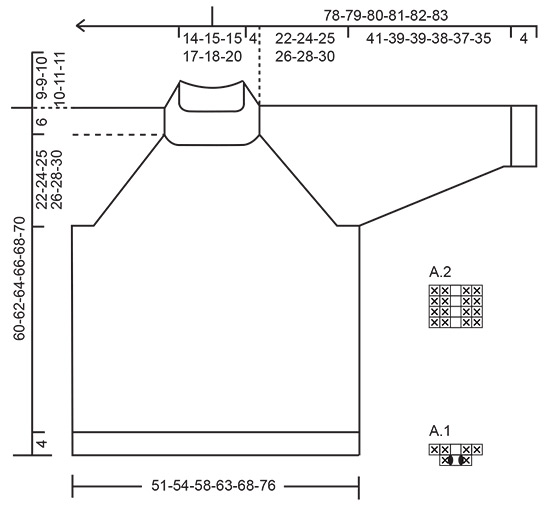
|
||||||||||
|
Have you made this or any other of our designs? Tag your pictures in social media with #dropsdesign so we can see them! Do you need help with this pattern?You'll find tutorial videos, a Comments/Questions area and more by visiting the pattern on garnstudio.com. © 1982-2024 DROPS Design A/S. We reserve all rights. This document, including all its sub-sections, has copyrights. Read more about what you can do with our patterns at the bottom of each pattern on our site. |
||||||||||







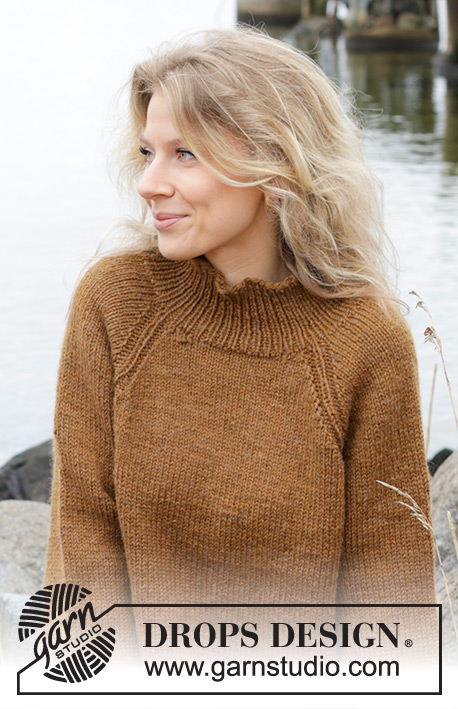
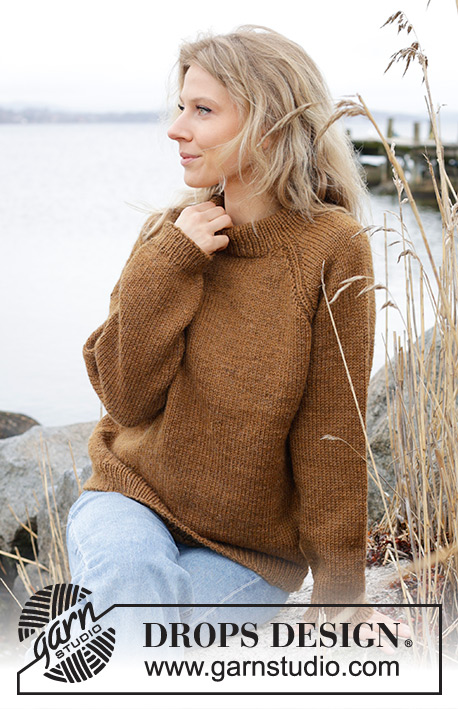

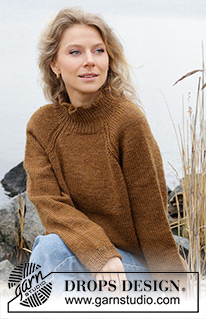
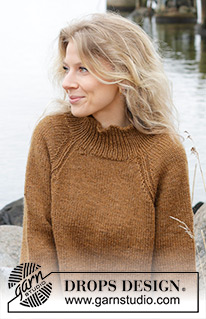
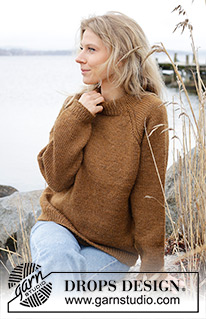


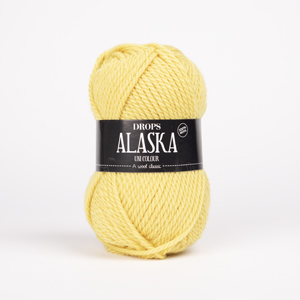






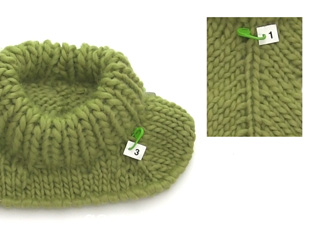




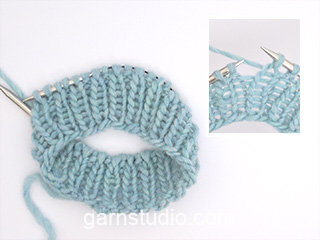



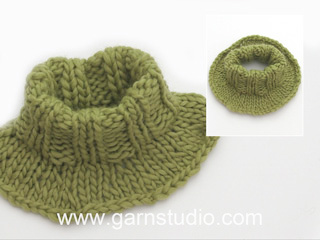











































Comments / Questions (12)
Dere må legge inn Raglan økning, kastene skal vries i riktig retning, f.eks slik: kastene strikkes vridd mot høyre på h side og mot venstre på v side...
22.01.2024 - 18:11Bonjour, Les raglans ne semblent pas se joindre sous la manche des deux côtés. Est-ce normal?
06.11.2023 - 22:50DROPS Design answered:
Bonjour Graziella, effectivement, en fonction de la taille, la division se fera à un endroit différent de A.2, mais quoi qu'il arrive, on tricote ensuite tout en jersey, on ne continue pas les mailles envers de A.2. Bon tricot!
07.11.2023 - 08:58Hi, i am fairly new at knitting so please help me understand the pattern. i have finished the neck ribbing and stuck. the pattern asks for dec but the total remaining St count doesn't add up... if your neckline is 96, how do you end up with 88 after total dec of 16 + 4 A1.
27.09.2023 - 03:08DROPS Design answered:
Hi Aman, You decrease stitches over each part of the round where you work stocking stitch; first decrease 2 stitches over the first section, then work A.1, then decrease 4 stitches over the next section and so on. You decrease in total 2+4+4+4+4+2=20 decreases. However, in each A.1 you make 2 yarn overs (increase 2 stitches), which gives you 8 increased stitches. So the final stitch number is 96-20+8=84 (not 88) in size S. Happy knitting!
27.09.2023 - 06:53Wieso ist der Beginn der Runde nach Stillegung der Ärmelmaschen nicht mehr in der hinteren Mitte sondern in der Mitte der neu angeschlagenen Maschen unter einem Ärmel?
18.09.2023 - 10:15DROPS Design answered:
Liebe Sylvia, so wird das Ende der Runde am Ende in der Seite, wo mehr unauffällig wird. Viel Spaß beim stricken!
18.09.2023 - 16:08En el aumento ranglán, ¿cómo distingo la parte de las mangas de la parte del delantero y espalda para hacer los aumentos solamente en alguno de ellos? Si hay que hacer 8 aumentos y luego 4, entiendo que los primeros aumentos serían en todas las partes y los 4 en sólo dos de ellas. ¿Cómo podría diferenciarlo? Gracias.
17.09.2023 - 19:25DROPS Design answered:
Hola Ana, en el cuello alto has insertado marcapuntos en cada sección: el 1 en la transición entre la espalda y la manga izquierda, el 2 entre la manga izquierda y el delantero, el 3 entre el delantero y la manga derecha y el 4 entre la manga derecha y la espalda. El inicio de la vuelta está en el centro de la espalda y se marca con otro marcapuntos. Los aumentos para el raglán se trabajan antes y después de A.1 (en la FILA 1) / A.2 (el resto de las filas). Cuando solo se trabajan los aumentos del cuerpo aumentar: antes del marcapuntos-1, después del marcapuntos-2, antes del marcapuntos-3 y después del marcapuntos-4.
17.09.2023 - 23:40Je begint de hals met Teltekening A1 tijdens de verdeling van de Panden vervolgens brei je 1 e naald verkorte rijen en pas bij de tweede rij zou je de omslagen breien maar als ik tel tekening 1 volg brei ik de omslagen al in de 1e naald Bij tel tekening a2 wordt niet gemeerderd?
17.09.2023 - 17:42DROPS Design answered:
Dag Astrid,
Klopt, je breit de omslagen van de eerste naald van A.1 gelijk al bij de paragraaf 'HOGE HALS'. (Deze omslagen brei je op de volgende naald gedraaid, om gaatjes te voorkomen.) Bij het breien van de halslijn maak je tegelijkertijd meerderingen voor de raglan aan elke kant van A.1
18.09.2023 - 20:26Ik ben er al uit. Ik weet niet hoe ik mijn bericht kan verwijderen
12.09.2023 - 08:27Ik heb hulp nodig bij het verminderen deel bij de Hogen Hals. Ik blijk niet goed te snappen hoe ik 2x verdeelt verminder op 13 steken, en/of 4x verdeeld verminderen op 19 steken enz. Ik heb het al eens geprobeerd maar kwam de laaste 12 steken tekort!? Ook heb ik het voorbeeld pagina al 3x door gelezen lol. Ik werk maat M op het moment. Alvast bedankt.
11.09.2023 - 16:52Almendra
06.08.2023 - 12:09Caramel leaf
04.08.2023 - 17:30